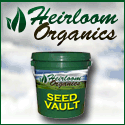Herbs
Herbs are one of the most interesting plants in existence. Throughout history they have been used in many different ways. They cure our illnesses, add flavor to our foods, provide pleasant, non-toxic scents, help control pests and beautify our yards. Their culinary uses often result in positive medical side effects. Many have natural antiseptic qualities. These include fennel, garlic, goldenrod, hyssop, marjoram, mint, rosemary, sage, southern wood and thyme.
Herbs are classified as annuals, biennials and perennials. Annuals bloom only one season, then die. Biennials live for two seasons, but bloom only the second season, Perennials, once established, will bloom every year.
A small garden area of 4 by 6 feet will generally grow all the herbs a small family will need. Herbs are some of the easiest plants to grow, and if you are new to gardening, they can teach you a lot.
- The Herb Garden -
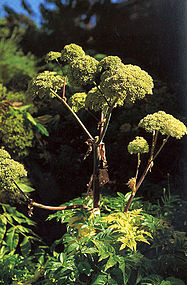
Angelica - Angelica archangelica
Biennial.
Bitter aromatic, antimicrobial, antispasmodic, stomachic and carminative.
Cultivate in ordinary deep, moist loam, in a shady area, does best in damp soil and loves to grow near running water.
It is used to make liqueurs like Benedictine and Chartreuse.
Angelica stimulates gastric and pancreatic secretions. It can be used as an antiseptic, diuretic, emmenagogue, and expectorant.
The seeds contain coumarin and should not be taken with prescription blood thinners.
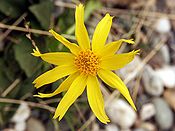
Arnica - Arnica montana
Herbaceous perennial for cold and hardy zones.
Sow in a mix of loam, peat moss, and sand in the spring. Likes acid pH, full sun, moisture, and a high altitude.
Medicinal herb used for sprains, bruises, soaks, compresses, and an ingredient for salves and oils.
The whole flowers are collected and dried, but the receptacles are sometimes removed as they are liable to be attacked by insects. The root is collected in autumn after the leaves have died down.
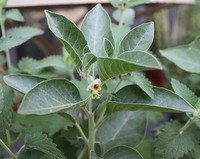
Ashwagandha - Withania
somnifera
Herbaceous perennial in the tropics, annual in temperate zones.
Start indoors and transplant to the herb garden as you would tomatoes. Does not tolerate cold conditions well.
Dried root is a Ginseng-like Ayurvedic tonic mainly for physical and mental exhaustion.
Easy to grow, unusual and useful, also increasingly popular herb for selling.
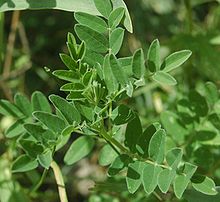
Astragalus - Astragalus membranaceous
Herbaceous perennial.
Direct seed in early spring, good cold soil germinator. Prefers full sun, average soil and good drainage.
Chinese tonic herb, with immune enhancing qualities. Improves function of liver, lungs, and spleen.
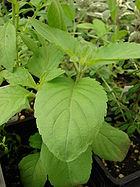
Basil - Holy Ocimum
sanctum
Tender Annual.
Usually brilliant green but can range from yellow-green to dark green depending on the soil. There are many varieties, including one that is reddish-purple.
Easy to grow. Prefers full sun, well drained, rich soil, and plenty of water. Makes a nice border plant. Sow directly or in greenhouse in
Spring or Summer. Sow seeds 1/4" deep and 12" apart, after all danger of frost is past or start indoors and transplant after soil has warmed. Pinch back tips before it flowers for a bushier plant with a longer growing season.
Companion plant to tomatoes. Enhances their flavor and protects them from harmful insects.
Sweetly pungent, with a minty-licorice flavor. A popular herb used to make pesto. Use in sauces, soups, stews, Mediterranean and Italian dishes. Preserve by storing in a glass jar covered with olive oil or freeze in ice cube trays covered by water or olive oil.
Adaptogenic, anti-fungal, antibacterial, antiseptic, emmenagogue, immune enhancing, mild nervine, and of the Ayurvedic tradition. Relieves headaches and nausea.Taken as an infusion, basil is a gentle tonic for nursing mothers that increases lactation and helps expel gas in infants.

Bay - Laurus nobilis
Also known as Sweet bay and Bay laurel. A stately fragrant tree that grows up to 60 feet tall in its native Mediterranean. It has smooth bark with dark green, shiny leaves. Symbolizes honor and glory.
Very difficult to propagate. Plant outside in average, well-drained soil, protected from sun & wind. Grow in large pots and bring indoors where winter is frosty. Indoors, trees will grow 3-6 feet tall.
Pick and use the leaves year-round or dry them.
Medicinally, bay is considered a gentle tonic, that is warming and drying. An infusion of the fresh or dried leaves helps expel flatulence and is helpful to the digestive organs.
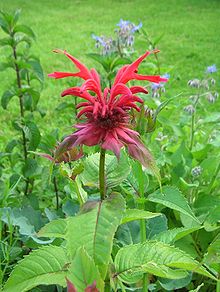
Bergamot - Monarda didyma
Perennial.
Prefers partial shade and moist, rich, somewhat acidy soil. Large, shaggy red flowers on tall stalks.
Flowers and leaves have a citrusy flavor. Favored by hummingbirds and bees.
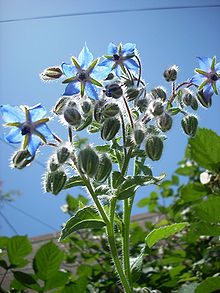
Borage - Borago
officinalis
Hardy annual.
Since ancient times, Borage has had a reputation for dispelling melancholy and fostering courage. Also known as "Bee's Bread" because they love the flowers.
Borage has dark green leaves and stems with prickly white hairs covering the entire plant. The beautiful blue or pink, star-shaped blossoms are accented with black anthers. It grows to about 18 inches tall and can get up to about 3 feet wide.
Easy to grow, will self sow. Direct seed in mid-spring after last frost. A single plant can spread over a 4 foot area, so allow plenty of room for it to expand. Prefers loose, well-aerated soil that is rich and moist. Mulch when plants are young.
Companion plant to improve the flavor of strawberries and tomatoes and is said to keep Japanese beetles off of potatoes
Pick leaves and flowers throughout the growing season. Edible
bright blue/purple/pink flowers for salads, teas and desserts. Put them in ice
cube trays for winter surprises. Flowers can be candied to decorate desserts.
For medicinal uses, harvest the leaves before the plant flowers and dry them in a warm (not hot) dark place. Heat causes them to loose their healing qualities. Borage has a cooling, calming effect and can break fevers, alleviate anxiety, and lower blood pressure. Serve the infusion as a cold tea.
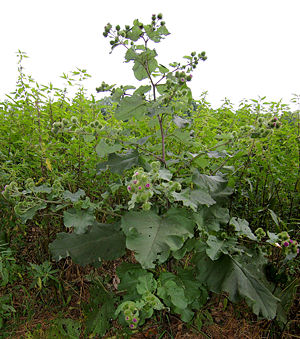
Burdock - Arctium lappa
Biennial or self seeding annual.
Burdock has long, dull green stalks and large, veined, oval leaves, that can be up to 12 inches long. The leaves resemble those of rhubarb. In the second year of growth, purple blossoms top the thick seed stalks, which are followed by spherical burrs covered with bristly stickers. The plant has a long thick taproot, which is the part used medicinally.
Direct seed in late spring, prefers slight shade with good drainage and sandy soil. Plant closely for best yield and proliferation. Harvest root during dormant period after the first year to make oil. It will grow in almost any soil, but the roots are formed best in a light well-drained soil. Sawdust is a good addition because it makes the roots easier to pull up. The seeds germinate readily and may be sown directly in the field, either in autumn or early spring, 18 inches to 3 feet apart, sowing 1 inch deep in autumn, but less in spring. The young plants when well up, should be thinned out to 6 inches apart in the row.
In the first year, the tender young leaves can be picked in early spring, blanched and used as a salad vegetable.The stalks can be peeled and served in a salad or cooked like asparagus.Fresh Burdock root should be peeled and sliced into thin rounds for soups, stir fry, vegetable and meat dishes.
Rich tasting miso broth, with sea and land vegetables, including Burdock root, is a classic Japanese soup. To make this healthy, elegant soup, saute the peeled, sliced root in a little olive oil, add sliced onion, garlic,carrot, bokchoy, mushrooms, wakame seaweed and about a 1 1/2 cups of water for each serving of soup. Simmer uncovered until vegetables are tender. Remove about a cup of broth and add 1 tablespoon of miso per serving of soup, stir until miso is dissolved. Just before serving stir miso into soup. Miso should not be boiled because it is fermented and boiling kills it.
Burdock increases strength and endurance and has nourishing and healing properties. A poultice made from the leaves has been used for centuries to treat gout and skin damage. In Chinese medicine, the seedpod is dried and used for coughs, colds, sore throats, boils and measles.The root has a warming, moistening effect and is an excellent tonic for the lungs and liver, and a good blood purifier. An infusion of the leaves, or a decoction of the root can be used as a wash for skin problems like acne, ringworm, measles and burns.
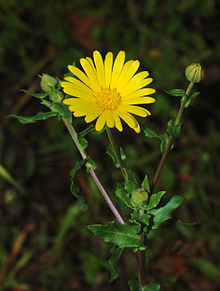
Calendula - Calendula
officinalis
Hardy annual and self seeding. Also known as pot marigold.
Calendula has been associated with the sun for centuries. It opens its flowers when the sun comes up and closes them when sets.
Very easy to grow. Direct seed in warm soil and full sun. Will proliferate fast and easily. The plant is bushy with flowers that are a bright orange-yellow and the leaves and stems are hairy. Harvest the flowers throughout year.
This herb is a premier healing agent in salves, tinctures or masticated and applied to external injuries.
Seeds sown in April, in any soil, in sunny, or half-sunny places germinate freely. Requires no other cultivation but to keep them clean from weeds and to thin out where too close, leaving them 9-10 inches apart, so that their branches may have room to spread. The plants will begin to flower in June, and continue flowering until the frost kills them. They will increase from year to year, if allowed to seed themselves. The seeds ripen in August and September, and if permitted to scatter will furnish a supply of young plants in the spring.
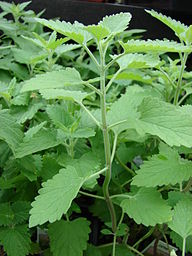
Catnip - Nepeta cataria
Herbaceous perennial.
Highly aromatic plant in the mint family. Also known as catmint and catswort. It has gray-green leaves that are toothed and heart-shaped. It grows 2-3 feet tall and its stems and leaves are covered with a fine down.
Catmint is easily grown in any
garden soil, and does not require moisture in the same way as the other
Mints.
Direct seed in the fall for best results or start in flats in mid-spring. Prefers warm soil and full/partial sun. Sow in rows, about 20 inches apart, thinning out the seedlings to about the same distance apart, as the plants attain a considerable size. Attracts bees and of course cats!
The flowering tops are the part of the plant used medicinally. Harvested when the plant is in full bloom by cutting the plant back to 3-4 inches above the ground.
The flowers are a gentle sedative, aromatic and calming.The root has the opposite effect. Catnip is an antispasmodic, and is useful for treating stomach complaints such as over acidity.
Catnip tea has calming properties. It can be used by adults and children for nervousness, restlessness, anxiety, headache, indigestion and cramping. Large doses will act as an emetic. It is also warming and can be used to break fevers. Do not boil catnip or it will lose its volatile oils and much of its healing qualities.

Cayenne - Capsicum annuum
Annual.
Spicy member of the pepper family.
The cayenne plant grows 2 to 6 feet tall, depending on the climate and soil. Its leaves are similar to those of the sweet pepper plant and its peppers are long and bright red. It needs lots of heat and sunlight to do well. It can be grown indoors with strong southern exposure, but its medicinal qualities will not be as good as if grown outdoors. Keep the soil moist.
Pick the pepper pods when they are red and hang to dry in partial sun. After they are dried, the pods can be powdered in a blender or coffee grinder. Be careful when handling the pods, cayenne will cause extreme irritation of the eyes and mucous membranes.
Cayenne opens capillaries and soothes the stomach and mucous membranes. It is a good tonic for the stomach and intestines, and is helpful in treating constipation. It can be mixed with warm water and bran and used as a poultice for chest and lung congestion. It is also useful for pain when added to liniments.
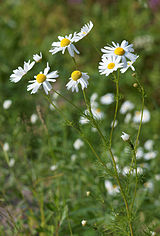
Chamomile, German - Chamomilla
recutita
Annual.
Self seeding and extremely vigorous. Sow seeds directly in Fall or
mid-Winter. Prefers full sun, and most types of moist soil. Chamomile is a compact, low-growing plant with tiny, daisy-like flowers. Harvest blossoms when they are in full bloom and dry them by hanging upside down in a warm shady place.
This is the
delightfully aromatic Chamomile of tea fame. Perfect for gentle bedtime
sedation or for treating stomachache and indigestion.The tea can also be used as a hair rinse to bring out natural blond highlights. Chamomile flowers can be made into a poultice or added to the bath to treat a headache or illnesses affecting the kidneys, liver or bladder. An infusion of the flowers can be added to the bath to calm hyperactive or irritable children.
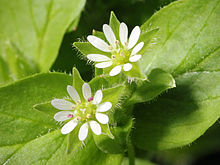
Chickweed - Stelleria media
Annual, spreading ground cover.
A wild herb in temperate climates. It can be found growing in moist shady places, under trees, especially oak trees. It has small light green paired leaves and tiny white, star-shaped flowers.
Direct seed in rich soil in early spring or late summer. Flowering no higher than 1 foot.
Harvest fresh for a wholesome, succulent and tasty salad green. Used daily,
this herb will assist in weight reduction. Also has liver and kidney cleansing properties.
Chickweed has emollient, demulcent properties. Dried, it makes a good addition to any healing salve. It is good for treating skin problems like rashes and inflammation. Crush the fresh leaves and use as a poultice.

Chives - Allium
schenoprasum
Perennial.
Mild flavored relative of onions, leeks, garlic and shallots.
Easy to grow & maintain, they are hardy & drought tolerant. Grows in
clumps with round, hollow leaves that taper to a point with edible light purple
blossoms. Grow in rich soil, sun or partial shade and keep the soil moist. They also grow well on a sunny windowsill. They are bothered by few insects or diseases. Planting them with rose bushes are said to protect the roses from black spot and Japanese beetles.
Chives contain a pungent volatile oil, rich in sulphur. The oil has antibacterial properties and is beneficial for blood circulation and for the respiratory & digestive systems. They also have high levels of vitamin A & C.
Chives are an ideal addition to herb butters, spreads and dips, tossed in salads, and as a flavoring for vinegars.

Comfrey - Symphytum
officinale
Perennial.
Also known as Boneset, Knitbone, Bruisewort, & Healing Herb, it is in the same family as Borage.
Comfrey grows 2-3 feet tall with leaves that are deep green, elliptical and up to a foot long. Tall & sturdy with hairy leaves at the base getting smaller towards the top. Sprays of flowers change from pink to blue as they open in the summer. The mucilaginous roots are about an inch thick and a foot or more long with a white interior and black exterior.
It is a hardy plant and prolific grower, it can quickly take over a garden. It will survive in almost any soil but prefers moist, fairly rich soil in full sun or partial shade. Propagate from root cuttings. It is a good food crop for rabbits and goats.
Both the leaf and root are used medicinally. To harvest the leaves, cut before the plant flowers. Spread in a single layer to dry in a shady, warm place. The roots should be harvested in the fall after the first frost or in early spring before new leaves appear. Wash them, cut into thin slices and dry on a screen in the sun. After drying, grind into a powder.
The root is cooling, mildly astringent, anti-irritant, and demulcent. It contains allantoin, a healing substance, and is rich in vitamin A, C, calcium, potassium, and phosphorus.
Use this herb for minor cuts, burns, boils, skin irritations, hemorrhoids, sprains and fractures. It can be used in a poultice or the powder can be sprinkled on the wound to promote healing.
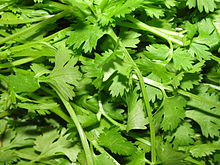
Coriander - Coriandrum
sativum
Annual.
The seeds of the plant are known as Coriander and the leaves are known as Cilantro or Chinese Parsley. Likes lots of sun and well drained soil.
Pungent herb, with two types of leaves: the lower ones resemble Italian parsley, the upper one are small and delicate. Tiny white flowers tinged with lavender, if left uncut will form a round, sweet flavored seed used in curries, cakes and breads.

Dandelion - Taraxacum
offinalis
Herbaceous perennial.
Dandelion is probably the world's most famous weed. Native to and distributed throughout all temperate
zones.The roots are thick and brown on the outside, with a white, milky juice inside. The leaves are shiny, smooth and toothed. The flowers are bright yellow, round and shaggy, on a succulent stem.
Sow seed in flats in the spring,and transplant to rows in the
garden. Space plants 1 foot apart, and keep well watered. Incorporate saw dust or wood chips into the soil to make it easier to harvest the roots.
All parts of the plant are edible and useful for healing. One ounce of fresh leaves contains large amounts of vitamin C, sodium, and potassium. Harvest the leaves early for salads, after the flower stalks reach full height the greens are too bitter to eat. The flowers can also be used in salads, cooked or made into wine.
Dandelion root is one of the oldest healing herbs. It has been used for centuries in Europe to treat diabetes. In the spring, the root contains levulose, a sugar easily utilized by diabetics. By fall, this sugar has changed to inulin, a starch also easily utilized by diabetics. Harvested in the spring or the fall, the roots can be peeled, parboiled and sauteed as a vegetable. It has a slightly sweet, bitter taste.
It is a gentle liver tonic and diuretic, and strengthens the spleen, pancreas and kidneys. It is a digestion aid and has laxative properties. It is one of the best herbs for building up the blood and curing anemia. Chop the roots and roast them at 200 degrees in the oven until brown and brittle, then grind and use as a coffee substitute or an addition to coffee. If ground very fine they can be used like instant coffee.
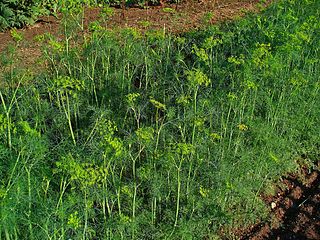
Dill - Anethum
graveolens
Hardy Annual.
In the Umbellifer family, resembles fennel.
Easy to grow. Makes a beautiful background plant in the garden. Plant in average, well drained soil where it gets plenty of sun and
is protected from strong winds. Plants should be about 10 inches apart. Feathery, fern like bright green foliage grows 2-3
feet tall with tiny yellowish flowers in umbrella-like clusters, that will mature into aromatic brown
seeds. Do not harvest leaves until plant is well established, then pick sparingly throughout the season until flowering begins. Use leaves fresh or dry on non-metallic screen in a warm, dark place. Harvest seeds when they are light brown.
Both the leaves and seeds can be used in soups, breads, pickles, salads and meats.
Dill is an appetite stimulant, and beneficial to the stomach. A tea made from the leaves and seeds can be used to treat breast congestion that comes from nursing, it also stimulates milk production, and dispels flatulence. The tea can be taken as often as needed. A mild infusion of the seeds can be used to relieve colic in babies.
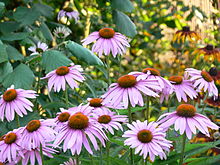
Echinacea Angustifolia - Echinacea
angustifolia
Herbaceous perennial.
Also known as Purple Coneflower. From the Composite family.
Grows from 1 to 5 feet tall with flowers resembling the Black-eyed Susan. Flowers range from purple to white.
Sow seed outdoors in very early spring or fall. Prefers full sun, with well drained, limey soil and regular watering. Do not over-water during growth cycle (roots can rot). This threatened species is being over-harvested in the wild.
Beloved medicinal herb that is used for its immune enhancing properties. It is one of the best blood and lymph purifiers as well as an effective antibiotic. The root is the part used for healing purposes and is harvested in the fall after the third or fourth year, but not after the fourth year. After several hard frosts it will die back, that is the time to harvest the root. Rinse the roots and cut them into 1/2-inch lengths. Set the root pieces on a nonmetal screen and place in a well-ventilated area that receives little to no sunlight. Leave the roots to dry for about two weeks, turning the pieces over every day.
Indian tribes used Echinacea to treat snakebite and poisonous insect bites, the juice was also used to treat burns.

Elecampane - Inula helenium
Herbaceous perennial.
Also known as "Horseheal" because it is used to treat pulmonary disorders in horses and "Scabwort" because of its effectiveness in healing scabs on sheep.
The large oval leaves resemble those of the Mullein plant and the flowers look similar to sunflowers. It grows 4-6 feet tall with leaves 12-18 inches long and up to 4 inches across.
Sow seed in greenhouse in early spring or sow
directly in garden in mid-spring. Light-dependent germinator. Grows in full
sun or partial shade. It grows well in moist, shady positions, in ordinary
garden soil, though it flourishes best in a good, loamy soil, with the ground
being damp, but fairly well-drained. Propagate from root cuttings or offshoots taken in the fall from a mature plant.
A soothing cough and lung remedy for treating asthma, bronchitis, bitter and antiseptic. Elecampane is a good medicinal herb that has a strong activity against bronchial infection, pneumonia and debilitating, chronic cough.The root is the part used for healing purposes and only the second year growth is good for medicinal purposes. It should be harvested in the fall of the plant's second year, after two hard frosts.
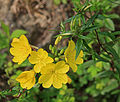
Evening Primrose - Oenethera
biennis
Self-seeding biennial.
Scatter seed on surface of disturbed soil in fall or early spring, or start on surface of flat and transplant. Seed requires exposure to light in order to germinate. Drought tolerant.
Some women report alleviation of PMS by eating the plant and the seeds.
The flowers especially make a tasty addition to salads.
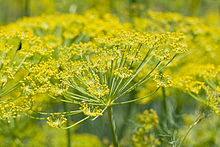
Fennel - Foeniculum
vulgare
Perennial in temperate climates.
A relative of Dill, Anise and Caraway
Plant in a sunny spot, protected from strong winds. Fennel likes rich soil and lots of sun. It is tall with thick, glossy stems covered with feathery fern-like green leaves. The 3-5 foot tall stalks are topped with tiny bright yellow flowers that turn into aromatic brown seeds.
Fennel has an adverse effect on bush beans, tomatoes, kohlrabi and caraway. Coriander and wormwood have an adverse effect on fennel, so all of these plants should be kept away from each other in the garden.
Leaves and seeds have a strong licorice
flavor and are good in sauces and soups. The stalk can be used in salads or sauteed with garlic and olive oil.
For medicinal purposes, Fennel seeds are used as a digestive aid to reduce flatulence and expel worms, as a gargle, an eyewash, and insect repellent. It also can be used to increase milk in nursing mothers. Make the seeds into a tea and drink 2 or 3 times per day, it is also a calmative.

Feverfew - Tanacetum
parthenium
Herbacious perennial, native to temperate zones of the world.
Self-seeding and vigorous. Prefers full sun or partial shade. Planting may be done in autumn, but the best time is about the end of April. Any ordinary good soil is suitable, but better results are obtained when well-drained, and of a stiff, loamy character, enriched with good manure.
Fresh leaves are tonic to prevent migraines.

Garlic - Alliumum sativum
Hardy perennial belonging to the onion family.
Since ancient Egyptian times garlic has been used as a food flavoring and for treating chest colds and catarrh, an inflammation of the mucous membranes. Modern research has also confirmed its role in treating heart and circulatory problems. Garlic helps thin the blood and there is evidence that it helps to reduce cholesterol levels. An old wives tale says garlic rubbed on a bald head will produce hair!
Garlic grows as a bulb underground. It is easy to cultivate, but does require a long growing season, lots of sun and rich, moist, sandy soil. Plant garlic in late fall or early spring. Cultivate soil, apply lime, tamp down and plant individual cloves about 2” deep. Dress with soot. Keep free of weeds and gather soil around roots. You can buy garlic for planting, use the same cloves you use for cooking or use cloves left over from last years harvest. Harvest garlic in the summer when the tops have turned brown and dried. Lift the bulbs from the ground, braid the tops and leave them in the sun to dry, hang in a cool, dry, airy place. Ripe garlic can be stored for up to a year, then it starts to sprout and loses its flavor.
Garlic or leeks will keep moles out of your garden. If placed near roses, it helps to repel aphids. It will keep a variety of insects away from many vegetables and herbs.
Garlic’s astringent qualities cut the fattiness of oils, dairy products and meats. Garlic is indispensable in salads, either used in a dressing or by rubbing the salad bowl with garlic.
Garlic will keep very well if you peel the cloves, place them in a jar and cover with oil, such as safflower or sunflower. The cloves stay firm and the oil is great for cooking & salad dressings. Refrigerate and keep the cloves in the jar covered with oil.
Medicinally, garlic can be used as an antibacterial, antihistamine, anti-parasitic, diaphoretic – perspiration inducing, digestive aid, expectorant and stimulant.
Garlic can be purchased in capsules and tablets, ointments, syrups and used raw or cooked.
A daily garlic supplement of 2 grams per day will help
prevent colds and strengthen the immune system and can be taken long term. Infuse several chopped cloves in a quart of water and use as a gargle or drink for cold and flu treatment.
For catarrh, take two 200 mg garlic capsules three times a day or eat a clove of garlic, raw or cooked and avoid mucus forming foods, such as refined carbohydrates, dairy products and alcohol. Zinc and vitamin C will also help combat the infection. Eat plenty of raw fruit.
For earaches: put a few drops of oil from a garlic capsule on a cotton swab or cotton ball.
For Atherosclerosis, high cholesterol or high blood pressure, take 1 gram of garlic daily in capsules or add at least one clove per day, per person in cooking.
Warnings: Garlic can irritate weak stomachs and sensitive skin. It should be avoided in high doses during pregnancy and while breastfeeding. Because of garlic’s anti-clotting properties, if taking anticoagulant drugs, ask your healthcare provider about using garlic and Inform your surgeon if you are taking garlic supplements.
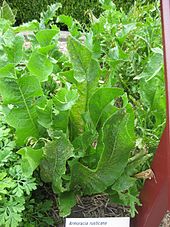
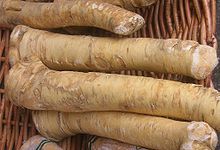
Horseradish - Armoracia
rusticana
Perennial.
Prefers cool, moist, well drained spot in full sun. Plant in loose soil so the root can grow freely. Tends to spread uncontrollably. Grows in lush clumps with large, elongated, floppy leaves, occasionally with a single stem of small white flowers growing from the center of the clump. Propagate from root cuttings.
The root is used for healing purposes. Harvest it in the fall and store in a cool, dark place. It is an antiseptic, stimulant, diuretic, and laxative. The fresh grated root is a good source of vitamin C and has been used to prevent scurvy and expel worms. An infusion can be used to treat asthma, coughs, pulmonary complaints, edema, and kidney stones. In poultice form, it can be used for muscle aches and chest congestion.
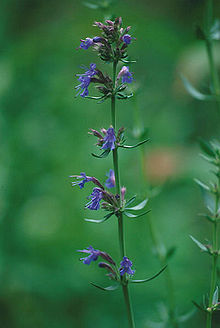
Hyssop - Hyssopus
officinalis
Woody perennial.
An evergreen herb and member of the mint family, hyssop grows 1 to 2 feet tall. Seed is easy to germinate. Prefers a dry location with full sun. Bushy, with dark green, narrow pointy leaves and spikes of red, white or blue flowers that are attractive to butterflies and bees.
May be propagated by seeds, sown in early spring, or by dividing the plants in spring and fall, or by cuttings, made in spring and planted in a shady spot. Plants raised from seeds or cuttings, should, when large enough, be planted out about 1 foot apart each way, and kept watered until established.
Hyssop is said to enhance the flavor and yield of grapes. It is also a good companion to cabbage and keeps destructive insects away.
After the plant is 18 inches tall, cut back the tops often to keep the leaves tender. Use the fresh tops in salads, soups and teas or dry for use later.
A great addition to
any herb garden. This mildly anti-viral and expectorant
herb makes an excellent tea to treat the common cold, fevers, coughs, sore throats or pulmonary complaints. It is also a stimulant, antiseptic, anti-rheumatic and diaphoretic. The bruised leaves can be used to treat minor cuts, scrapes and bruises by applying directly to the effected area.
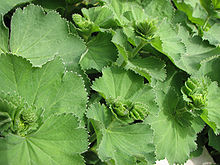
Lady's Mantle - Alchemilla
vulgaris
Perennial.
Plant in good soil with full or partial sun. Great for borders. The pleated, downy scalloped leaves will open 4-8 inches in diameter.
The clusters of yellow-green flowers bloom freely all summer and the leaves can be used in skin preparations.
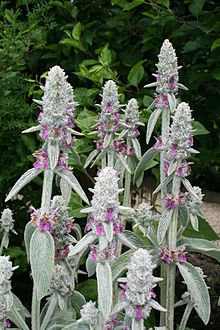
Lamb's Ears - Stachys byzantina
Perennial.
Plant in full sun and well drained soil. The downy gray-green leaves are covered with woolly hairs and can become quite large. Tall flower spikes with tiny purple blossoms rise out of the leaves.
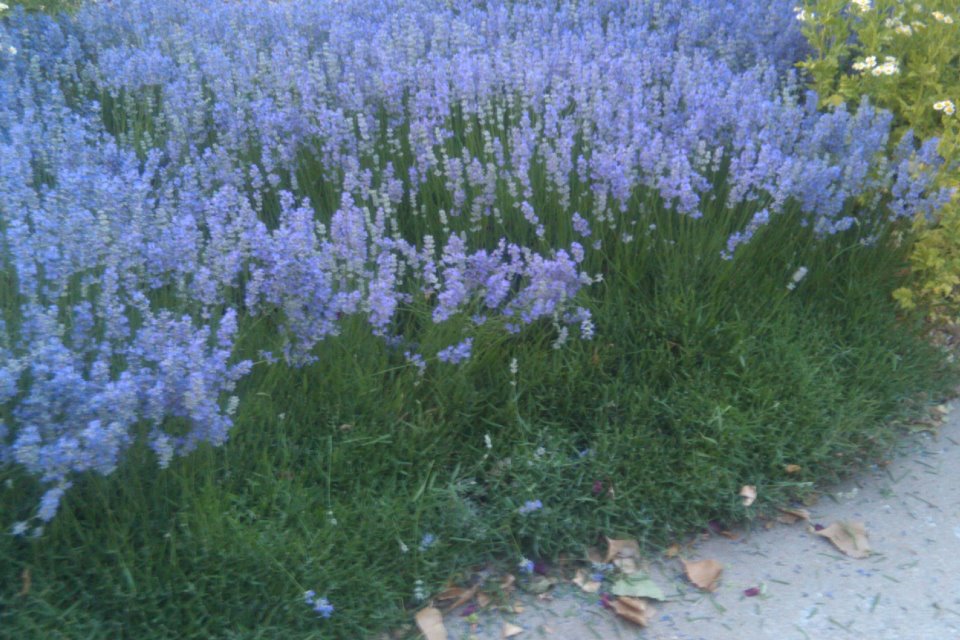
Lavender - Lavandula
angustifolia
Woody perennial.
A bushy plant with woody stems, small gray-green leaves and highly aromatic flowers that grow on long spikes and appear in midsummer. They grow 1 to 4 feet tall
Sow in flats and keep in partial shade, or sow dry seed in the fall or early spring in outdoor nursery beds. Transplant to pots or out to the garden after the slow-growing seedlings produce 4 or 5 leaves. Cut back to encourage bushiness. Lavender prefers full sun and dry, alkaline sandy soil. Drought tolerant. Cut back and mulch where winters are harsh. Established plants make nice borders and hedges.
Harvest flowers by cutting about 6 inches below the spikes, bundle and dry upside down.
Lavender became popular in mideval Europe for a variety of medicinal purposes. It has calming properties and can be used to relieve nervous headaches and depression. Use the flowers in tea to calm nerves, stimulate the appetite, relieve colic and flatulence. Used in the bath it is good for treating aches, insect bites, and sleeplessness. An infusion can be used as a gargle for sore throats, or as a compress for chest congestion. The flowers can also be placed around the house or rubbed on the skin to repel flies and mosquitoes. The essential oil can be added to just boiled water, and the steam inhaled to relieve cold and flu symptoms.

Lemon Balm - Melissa
officinalis
Herbaceous perennial.
A member of the mint family, the leaves have an invigorating lemony fragrance when crushed. A nice addition to potpourris.
Grows 1-2 feet tall with toothed leaves and small bunches of white or yellowish flowers that appear in midsummer. Prefers shade or partial shade but will grow in full sun. Thrives in normal garden soil and minimal water. Established plants can easily be divided and replanted. Plant 1.5 feet apart. Spreads less than other members of the mint family. Pinch or cutback once it flowers to encourage bushiness. Dry the leaves on the stem in a war, dark, airy place.
Lemon balm is helpful in treating the nervous system and is a favorite tea herb for its aromatic & sedative uses, lowering fevers, and treating stomachache and irregular menstruation. Mildly anti-viral, the leaves can be used to heal wounds and bruises.
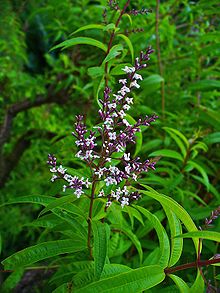
Lemon Verbena - Aloysia
citriodora
Tender perennial.
A lemony scented shrub with spear shaped leaves and sprays of tiny lilac or white flowers that appear in late Spring or early Summer. Propagate from cuttings.
Can be grown in normal, well drained soil in a sunny, sheltered area where the temperature doesn't get below freezing.
The leaves make a refreshing tea and can also be used in sauces, stuffings, cakes and ice cream. Use discretion because the flavor is strong. When dried, the leaves will retain their scent for years. They help deter insects and are good for use in potpourris and sachets. Use caution when using in skin care products as the oil sensitizes the skin to sunlight.
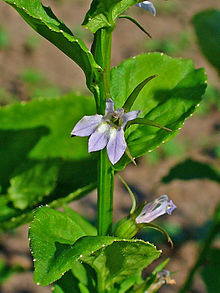
Lobelia - Lobelia inflata
Hardy annual.
Also known as Indian Tobacco because early settlers smoked it to relieve chest infections and asthma.
Grows 8-24 inches tall, has hairy stems and ovate, toothed leaves with tiny inconspicuous pink or lavender flowers. Press tiny seed into surface of flat and water lightly. Water or mist, light dependent germinator. Prefers full sun to partial shade and lots of water.
Useful anti-spasmodic, expectorant and emetic when combined with more soothing herbs. In small doses it dilates the bronchioles and is effective in treating asthma, bronchitis and pleurisy.
Use caution; one of its common names is puke weed. Should only be used by qualified practitioners.
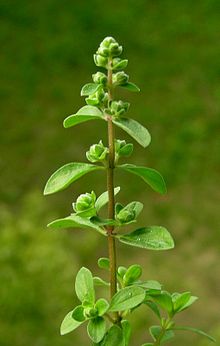
Marjoram - Origanum
marjorana
Tender perennial.
A native of Portugal, its name come from the Greeks and means "joy of the mountains". Related to oregano.
Hardy only in warm climates. Generally grown as an annual. Plant in full sun in a light rich soil. Bushy, with tiny white flowers and small green oval leaves that have a sweet mild flavor.Prefers a sunny location and well-drained soil. Pinch back before it blooms, and later when it is ready to flower again, cut back to about one inch above the ground. Dry the leaves.
A popular kitchen herb used to flavor soups and stews.
A sedative herb used as a nervine and calmative. The steam from a hot infusion helps open respiratory passages. A strong infusion can be used as a gargle for sore throats or to treat mouth infections. A infusion soaked compress can be placed over the sinus areas to relieve congestion and hay fever.

Marshmallow - Althaea
officinalis
Herbaceous perennial.
Sow seed in greenhouse in early spring, or direct seed to fertile garden bed. Transplant out to moist, sunny location when seedlings reach 2 inches. Prefers regular watering and makes a lot of biomass, both above the ground and below.
The entire plant contains high-grade mucilage which stimulates phagocytosis, thereby enhancing immune function. The leaves and flowers, when dried, make a healing tea, very acceptable to those who are having difficulty swallowing liquids. It is soothing to throat and urinary tract.
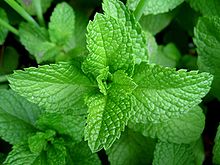
Mint - Mentha
Perennial.
Mints have cool, stimulating and refreshing properties. There are many varieties. Other family members include bee balm, catnip, horehound, hyssop, marjoram, penny royal, sage, and thyme.
Hardy with small flower spikes in shades from white to pink to violet. Plant in rich, fairly moist, slightly acidic soil in full sun or partial shade. Fast spreading if not contained.
Medicinally, the mint family is carminative, diaphoretic and stimulating. The most useful for healing purposes are:
peppermint, the most stimulating to the circulation,and a stronger remedy for flatulence and indigestion. A strong infusion will produce perspiration which is helpful in breaking fevers. It is also good for treating headaches, relieves tension, insomnia and nervousness.
spearmint, is not as strong as peppermint. It is helpful when treating children and the aged. It is mildly tonic, antispasmodic, stimulating and diaphoretic. Use a tea or infusion for treating flatulence, indigestion, nausea, heartburn and motion sickness. Mice are said to dislike spearmint and will go elsewhere if you scatter the leaves where they are a problem.

Motherwort - Leonurus cardiaca
Herbaceous perennial.
In ancient Greece it was given to pregnant women to calm their anxieties.
Tall, hardy and strong smelling, it grows to 4 feet tall. It has square, hollow stems with deeply toothed, prominently veined leaves, and pink flower spikes that bloom through the summer.
Start in flats, transplant out in spring or late
summer. Harvest in early flower, at least twice a season. Prefers moist, well-drained soil in a sunny location.
Dry the flowering top for use in infusions, extracts and tinctures. Very useful as a mild sedative, heart tonic, calming nervine, emmenagogue and aperient. It is antibacterial and anti-fungal.
Cautions: Modern herbal medicine does not advocate giving it to pregnant women because it may stimulate the uterus.
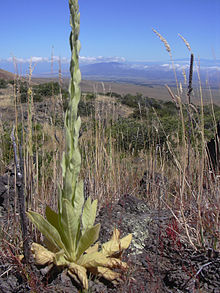
Mullein - Verbascum thapsus
Hardy Biennial.
Mullein has 6-15 inch long, furry leaves and tall yellow flower stalks. Sow seed on surface of disturbed soil or on surface of flat.
Compact down hard. Tolerates poor, gravelly soil and fierce sun. Self sowing.
Pick the flowers individually as they bloom. Dry them in a shady, warm place and store in an airtight container. Harvest the leaves before the flowers bloom, taking no more than 30% of the leaves from the plant. Harvest the roots in the fall.
The leaves, root and flowers are used medicinally as tea or tincture for moistening mucous membranes and is a great soothing agent for the throat, bronchi and lungs.
The flowers are stronger than the leaves, have bactericidal properties and are helpful in relieving earaches and respiratory problems. They are also antispasmodic, demulcent, emollient, astringent, and have sedative properties.
The root has stronger sedative properties.
Caution: The seeds are toxic and should not be used for any reason.
An infusion of the flowers can be used as a rinse to brighten blond hair.
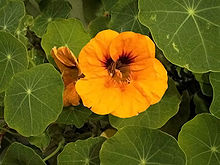
Nasturtium - Tropaeolum majus
Annual.
Also known as Indian Cress.
Prefer full sun, except in very hot locations, and ordinary soil with good drainage. The big round, bright green leaves are dotted with open faced flowers in red, orange, yellow, maroon and white all summer and into early fall.
Leaves and flowers are high in vitamin C and have a peppery flavor that is
good in sandwiches and salads.The flowers also can be used as a flavoring for vinegar. Pickled nasturtium seeds, can be used like capers.
The seeds have antiseptic, antibacterial properties and used in infusions for treating urinary and upper respiratory tract infections.
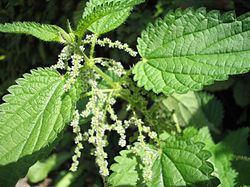
Nettle - Urtica dioica
Herbaceous perennial.
Also called Stinging Nettle.
Thorny plant that grows 2-3 feet tall. Often found in the wild in moist, nitrogen-rich soil. Resembles mint with its toothed, heart-shaped leaves. It has greenish flowers.
Sow seed indoors late Winter early Spring, transplant
in Spring after the last frost. Prefers either sun or shade and moist soil. Propagate from runners. Contain to keep from spreading.
Harvest in evening or early morning for highest essential oil content. Wear gloves
Sauteed or
steamed fresh spring herb, dried leaf has nutritive & medicinal uses. Cooking removes the sting.
A
popular tea for its nutritional value. It contains an array of vitamins and minerals. The high iron content
makes it an effective treatment for anemia. It is strengthening and is
recommended for pregnant women and nursing mothers. Nettles increase milk production, are nutritive to the liver, have diuretic properties and help with weight loss. Foot baths of nettle tea are an old treatment for rheumatism.
Caution: Be aware, entire plant covered in stinging hairs which inject formic acid, causing painful welts.
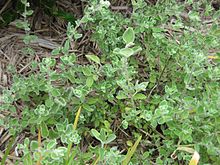
Oregano - Origanum vulgare
Perennial.
Prefers full sun and light, well drained soil that is slightly alkaline. A bushy, aromatic plant with larger, soft oval leaves that grow in pairs along the stem. Covered with clusters of pink to purple flowers in summer and fall.
Sometimes known as wild marjoram and a close relative of that plant.
A flavorful herb used in Mediterranean, Italian and Greek cooking.
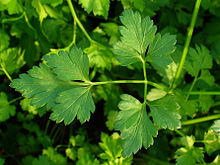
Parsley - Petroselinum
crispum
Biennial.
Grown as an annual because in the second year the leaves are
tough and it flowers and quickly goes to seed. Plant in rich, well drained
soil in full sun or partial shade.The curly leafed variety grows about 6 inches tall. The flat leaf variety grows about 12 inches tall. Seeds are slow to germinate.
The most used culinary herb. No herb garden should be without it. Due to the high content of chlorophyll, parsley freshens the breath and neutralizes indigestion. It also contains vitamins A and C, calcium, thiamin, riboflavin, and niacin. Pinch the leaves back throughout the growing season as needed for cooking.
Both the leaves and root are used medicinally. Harvest the whole plant in late summer for healing preparations. It is useful as a diuretic, and liver tonic, and helpful in treating anemia, kidney stones, and coughs. A poultice can be made to treat swollen breasts in nursing mothers or relieve insect bites. An infusion of the leaves can be used as a shampoo or soothing lotion or in a foot bath to treat menopausal symptoms, painful menstruation and asthma. The root can be used as a laxative, or in a decoction along with the leaves for treating skin diseases, vaginal discharge and circulatory problems.
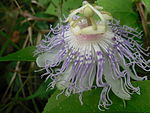
Passionflower - Passiflora
incarnata
Herbaceous or woody vine.
Sow the seeds about 1/2 inch deep in good, moist potting soil in a wooden flat. Transplant in late Fall or early Spring. Plant 2 feet apart and trellis on the sunny side of a building or on a fence.
Useful in treating insomnia and nervousness.
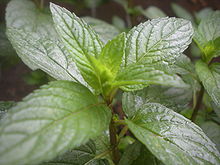
Peppermint - Mentha piperita
Perennial.
Seed is easy to germinate, and will grow prolifically. Prefers full sun to part shade. Thrives best in a fairly warm, preferably moist climate, and in deep soils rich in humus. Mature plants can be easily divided and transplanted to 1 1/2 ft. apart.
Folklore has it that planting mint near your front door brings protection and prosperity.
Mint is excellent for making a stimulating and digestive tea.
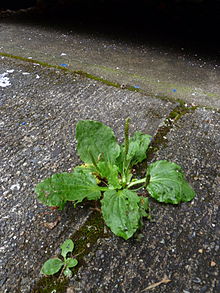
Plantain - Plantago major
Herbaceous perennial.
Also called snakeweed. Native Americans used the juice to treat rattlesnake bites.
Grows wild throughout the United States. Considered to be a prolific weed. Plantain has a rosette of ribbed leaves with a seed stalk growing from the center. Press seeds into surface of soil and keep moist. Prefers cool soils for germination. Plants prefer sun or shade, a moist soil, are not particular about fertility, but given water and compost will attain very impressive size.Harvest the leaves before the flower stalk matures and dry them in the shade on a screen.
The tiny mucilaginous seeds of the plantain are called psyllium seeds and are used as a bulk laxative. The plant can be used in poultice form for relieving the pain of wounds, insect bites, stings, inflammation, hemorrhoids and burns.
Anti-microbial and anti-inflammatory. Particularly useful as a first-aid poultice and herbal remedy for dental infections.
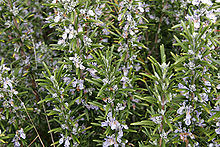
Rosemary - Rosmarinum
officinalis
Perennial evergreen in warm climates.
A woody evergreen shrub. It has small, narrow dark green needle-like leaves and tiny blue flowers. It can grow up to 5 feet tall. Must be taken in for winter where
temperatures fall below zero. Prefers sandy, well drained soil in full sun,
but will grow in partial shade. Can be grown from seeds but it is easier to start from cuttings.
Rosemary leaves and flowers are used medicinally. They are harvested after the second year. Cut back the stems just before or during the flowering period. Harvest no more than 1/3 of the plant in a season. It is useful in treating depression and other nervous diseases. It is antiseptic and astringent, dispels mucous from the stomach, relieves gas, calms a nervous stomach and restores digestion. Drink an infusion of the leaves and/or flowers several times daily. As a tea it is used to treat insomnia, headaches and mental fatigue.
The infusion can also be used as a hair rinse to treat dandruff.
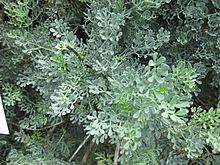
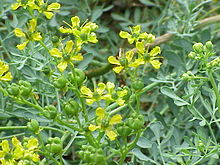
Rue - Ruta graveolens
Perennial.
An evergreen shrub with deeply divided blue-green leaves and small yellow, four-petalled flowers that bloom in midsummer. Plant in slightly alkaline, well drained soil in full sun.
Bitterest of all the herbs, it is also one of the most beautiful.
In the 17th century it had a reputation as an antidote to poison and defense against disease. It was an ingredient of the anti-plague concoction, Four Thieves Vinegar and was placed in the courtroom to protect the judge from diseased prisoners. Because of its potent smell and protective attributes it was used as a anti-withcraft and spells herb. Today it has few herbal uses and is recognized as a toxic irritant.It is a skin irritant and can cause blistering. It does have insect repellent properties.
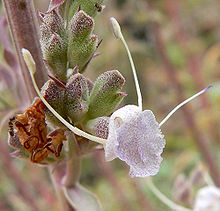
Sage, White Ceremonial - Salvia apiana
Herbaceous perennial.
Sow seeds in very sandy soil and water once daily. Bring indoors for winter, unless you live in a warm/mild climate. Loves a dry, sunny exposure.
Burned ceremonially to cleanse the spirit and welcome positive thoughts.
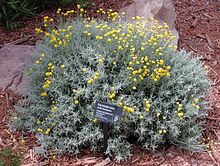
Santolina - Santolina
chamaecyparissus
Perennial.
Plant in average, slightly acid, well drained soil in full sun.
Aromatic with rough finely divided silver-gray leaves. If left uncut, it will be covered with masses of yellow button flowers.
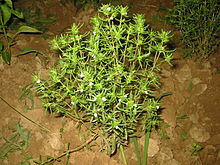
Savory, Summer - Satureja
hortensis
Annual.
Plant in rich, light soil where it will get plenty of sun and moisture.
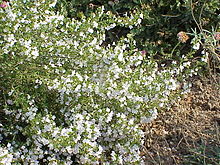
Savory, Winter - Satureja montana
Perennial.Evergreen in warmer climates.
Prefers poor soil with less moisture.
Both summer and winter savory are peppery, aromatic plants resembling thyme in both taste and appearance but with larger leaves and small flowers ranging from white to pink and lavender.
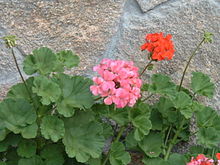
Scented Geraniums - Pelargonium
species
Tender perennial.
In cool climates must be brought indoors for winter, but make good houseplants. Give them plenty of sun, well drained soil and water during dry spells. With their exotic range of fragrances and different shaped leaves they are enjoyable plants to grow. They include lemon, lime and other fruit-scented varieties, nutmeg, ginger, oakleaf, as well as the old-fashioned rose geranium.

Schisandra - Schisandra
chinensis
Perennial woody vine.
Soak berries overnight and remove seed from fruit before planting. Plant outdoors in fall or early spring. Likes a shady situation. Cold hardy.
Used in Chinese medicine as an immune-enhancing herb.

Self Heal - Prunella vulgaris
Creeping herbaceous perennial.
Sow seed in very early spring in a flat outdoors or give a short, cold and moist conditioning treatment before sowing in a warm place.
The dried flowers make a pain-relieving, astringent tea to treat canker sores.
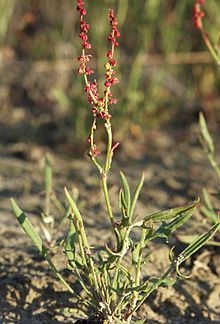
Sheep Sorrel - Rumex acetosella
Perennial grassland herb with rust colored flowers.
Easy to cultivate and vigorous. Sow seeds in Spring. Prefers full sun and good garden soil.
This is the species called for in the herbal formula "Essiac".
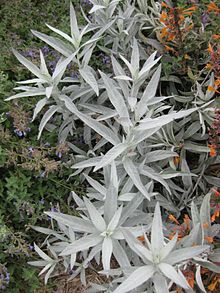
Silver King Artemisia - Artemisia ludovicianna
v. albula
Hardy Perennial.
Graceful stems of whitish leaves with sprays of little yellowish-white flowers appearing in mid to late summer.
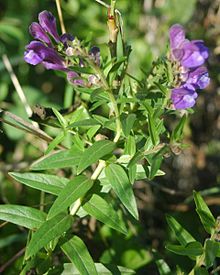
Skullcap - Scutellaria
baicalensis
This is a very striking bedding plant, bearing beautiful flowers. There is
an on-going demand for the root, which attains harvestable size after only
2 years. Sow seed in early spring. Germinates in about 24 days. Prefers
well-drained soil in the full sun. Cold hardy. Space plants 12 inches
apart. Grows to around 12 inches tall. Established plants get wider and
bushier.
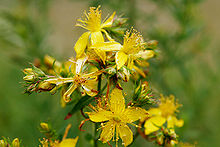
St John's Wort - Hypericum
perforatum
Perennial.
Light-dependent germinator in spring transplant out in summer. Use very sandy soil mix. Prefers full sun. Drought tolerant. Good choice for borders and banks.
Traditionally used for very mild depression and helps restore damaged nerve tissue.
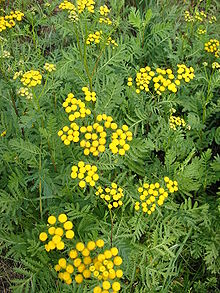
Tansy - Tanacetum vulgare
Perennial.
Prefers full sun. Forms a mound of fine silvery-grey foliage with small white, yellow eyed daisies. Blooms from early summer to mid fall.Grows 12 - 18 inches tall. Great for borders. Attracts butterflies. Drought tolerant.
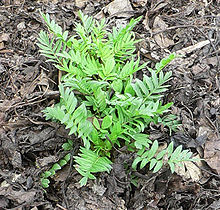
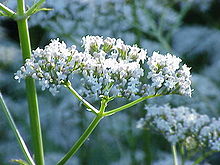
Valerian - Valeriana
officinalis
Herbaceous perennial, creeping and self-seeding.
Sow lightly on surface and keep moist; light dependent germination. Prefers full sun to part shade and lots of moisture.
Harvest dormant root after 2nd year for its strong sedative action.
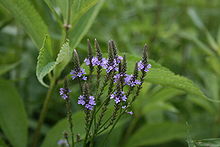
Vervain - Verbena hastata
Herbaceous perennial.
Seed requires cold conditioning before it will sprout. Sow in very early spring, or refrigerate in moist medium for 2 weeks before planting in the greenhouse.
Bitter remedy for indigestion, colds and fevers.
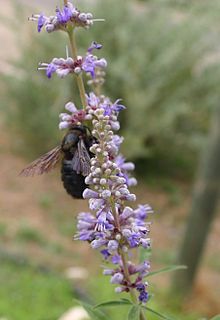
Vitex (Chaste Tree) - Vitex
agnus-castus
Perennial, deciduous shrub to small tree.
Sow in pots for first year and transplant outdoors. Prefers full sun, and dry soil.
The leaves and flowers exude exotic aromas.
Seeds are used to regulate hormones and support breast health.
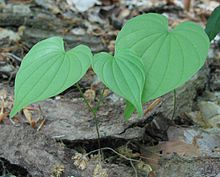
Wild Yam - Dioscorea villosa
Perennial.
Sow the seeds in the Fall, midwinter or early Spring, directly in prepared woodland beds or in the greenhouse. If started in the greenhouse, grow out for a year (keep moist/shaded) in gallon pots before transplanting to the garden or naturalizing in the forest. Likes good, humus soil and partial sun.
It is an antispasmodic helping to smooth muscles, which includes the gastrointestinal tract and uterus.

Wood Betony - Stachys
officianalis
Herbaceous perennial.
Very easy to start from seed. Takes 2 years to flower, but well worth the wait. This moisture loving plant prefers part sun or shade and normal garden soil. Has beautiful red/purple flowering spikes that attract bees.
Tea is made from dried leaf and is useful herbal remedy for headaches and mild nervine.
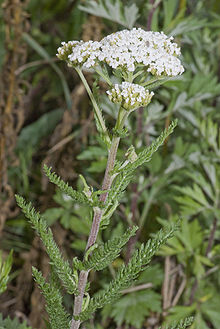
Yarrow - Achillea
millefolium
Perennial.
Also known as Soldier's Woundwort or Milfoil.
Feathery, fern-like leaves with cluster of tiny white flowers.
Sow seeds directly in early Spring. Grows vigorously in any kind of soil and requires little water. Prefers full sun.
A good border plant in the garden. Repels ants, flies and Japanese beetles and attracts beneficial wasps and ladybugs. Planted near buildings it is supposed to keep termites away.l
Yarrow flowers are
famous for their antiseptic and anti-inflammatory properties. The leaves, flowers and stems are all used for healing purposes. Harvest when the plant is in full bloom. Cut the leaves from the stems and dry separately. Hang the stems and flowers in bunches, upside down to dry. Store the flowers and stems separately. Yarrow is a good styptic. Fresh leaves can be mashed and applied directly to wounds or the dried, powdered herb can be sprinkled over cuts and abrasions. A tea made from the leaves, stems or flowers is beneficial to rashes, ulcers and hemorrhoids. The fresh root has anesthetic properties and is sometimes applied to the gums or teeth to relieve toothache.

